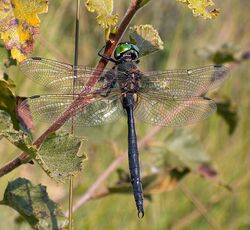Biology:Northern emerald
| Northern emerald | |
|---|---|

| |
| Male | |
| Scientific classification | |
| Domain: | Eukaryota |
| Kingdom: | Animalia |
| Phylum: | Arthropoda |
| Class: | Insecta |
| Order: | Odonata |
| Infraorder: | Anisoptera |
| Family: | Corduliidae |
| Genus: | Somatochlora |
| Species: | S. arctica
|
| Binomial name | |
| Somatochlora arctica (Zetterstedt, 1840)
| |
| Synonyms[1] | |
| |
The northern emerald (Somatochlora arctica) is a middle-sized species of dragonfly first described by Johan Wilhelm Zetterstedt in 1840. The male can be recognised by its pincer-like appendages and its narrow-waisted body. The female has distinctive orange-yellow spots on (only) the third segment of the abdomen.
This species lives in bogs and lays its eggs in very small water-filled depressions. It hunts between trees and avoids open spaces.
In Great Britain, it is only present in north-western Scotland and is confined to the south-western part of Ireland.[2] It is present in all of northern Eurasia. In Western Europe, it is present in alpine areas and wherever a suitable habitat can be found. It is found in the Rila mountains of Bulgaria.
References
- ↑ "World Odonata List". University of Puget Sound. https://www.pugetsound.edu/academics/academic-resources/slater-museum/biodiversity-resources/dragonflies/world-odonata-list2/.
- ↑ "Somatochlora arctica - Northern Emerald". British Dragonfly Society. 2011-05-28. http://british-dragonflies.org.uk/species/northern-emerald.
Wikidata ☰ Q674064 entry
 |

